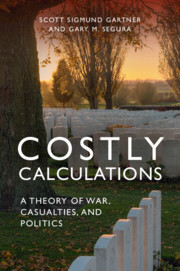Book contents
- Costly Calculations
- Costly Calculations
- Copyright page
- Dedication
- Contents
- Figures
- Tables
- Acknowledgments
- 1 Introduction
- 2 A Price Theory of War
- 3 Calculating War’s Price: What’s It Worth, and How Much Will It Cost?
- 4 The Price Theory of War in Action: Experimental Demonstrations of the Impacts of Expected Costs and Valuable War Aims
- 5 Conflict Dynamics across Space and Time: Public Opinion in the Korean and Vietnam Wars
- 6 Getting Wartime Information from Over-There to Over-Here: News Media and Social Networks
- 7 Elite Opinion Formation and Its Electoral Consequences
- 8 Conclusion: Wars, Casualties, Politics, and Policies
- Bibliography
- Index
6 - Getting Wartime Information from Over-There to Over-Here: News Media and Social Networks
Published online by Cambridge University Press: 18 June 2021
- Costly Calculations
- Costly Calculations
- Copyright page
- Dedication
- Contents
- Figures
- Tables
- Acknowledgments
- 1 Introduction
- 2 A Price Theory of War
- 3 Calculating War’s Price: What’s It Worth, and How Much Will It Cost?
- 4 The Price Theory of War in Action: Experimental Demonstrations of the Impacts of Expected Costs and Valuable War Aims
- 5 Conflict Dynamics across Space and Time: Public Opinion in the Korean and Vietnam Wars
- 6 Getting Wartime Information from Over-There to Over-Here: News Media and Social Networks
- 7 Elite Opinion Formation and Its Electoral Consequences
- 8 Conclusion: Wars, Casualties, Politics, and Policies
- Bibliography
- Index
Summary
The local information environment reflects a community’s experience with a war’s local casualties. As this experience varies across communities, so too does the information environment. The intensity of the experience is also reflected in the information environment. When a community has suffered more wartime losses, those deaths receive more coverage, even when we control for community-specific factors and size. While national media are more likely to report on international stories in general, specific local media give more attention to an international story if it includes local casualties. These local news stories include powerful elements, most notably military funerals and flag-draped coffins that make the stories vivid and highly influential. These scripted events represent standard, well-known symbols of loss that clearly and powerfully convey the cost of combat, directly affect ETC, and therefore significantly dampen public support for fighting a war. Social networks also contribute to individuals having varied levels of information about a war’s costs that in turn influence their variation in predictions of a war’s ETC and powerfully alters their views.
Keywords
- Type
- Chapter
- Information
- Costly CalculationsA Theory of War, Casualties, and Politics, pp. 160 - 188Publisher: Cambridge University PressPrint publication year: 2021



